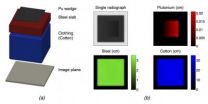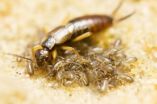(Press-News.org) WASHINGTON D.C., April 15, 2014 -- According to the International Atomic Energy Agency (IAEA) the greatest danger to nuclear security comes from terrorists acquiring sufficient quantities of plutonium or highly enriched uranium (HEU) to construct a crude nuclear explosive device. The IAEA also notes that most cases of illicit nuclear trafficking have involved gram-level quantities, which can be challenging to detect with most inspection methods.
According to a new study appearing this week in the Journal of Applied Physics, coupling commercially available spectral X-ray detectors with a specialized algorithm can improve the detection of uranium and plutonium in small, layered objects such as baggage. This approach enhances the detection powers of X-ray imaging and may provide a new tool to impede nuclear trafficking.
The study was conducted by a joint research team from the University of Texas at Austin (UT) and the Department of Energy's Pacific Northwest National Laboratory (PNNL).
"We first had to develop a computational model for how X-rays move through materials and how they are detected so that we could predict what an image will look like once the radiation passed through an object," said UT's Mark Deinert, one of the authors on the paper. "With that in hand, we applied an 'inverse algorithm,' varying the composition of the object until the predicted image matched the measured one. We also gave our algorithm additional details about density and other factors—a process called 'regularization'— to adaptively enhance its ability to discriminate materials."
The new system, Deinert said, expands upon techniques originally developed for medical applications such as discerning between bone and iodine contrast agent in an X-ray image. "We wanted to show that spectrally sensitive detectors can be used to discriminate plutonium and other high-atomic-number elements from multiple layers of other materials using a single-view radiograph," said Andrew Gilbert, the lead author on the paper and a doctoral student of Deinert's working at PNNL. "In simulated radiographs, we were able to detect the presence of plutonium with a mass resolution per unit area of at least 0.07 gram/centimeter squared; in other words, we can locate a sample of plutonium with a thickness of only 0.036 millimeters."
Now that the inverse algorithm method has been shown to help X-rays detect nuclear materials in luggage and other small objects, Deinert said that his team will next expand the concept to improve detection on a larger scale. "We plan to apply the algorithm to high-energy X-ray systems that could be used for verification of arms-reduction treaties," he said.
INFORMATION:
The article, "Non-invasive material discrimination using spectral X-ray radiography" by A.J. Gilbert, B.S. McDonald, S.M. Robinson, K.D. Jarman, T.A. White and M.R. Deinert is published in the Journal of Applied Physics on April 15, 2014 (DOI: 10.1063/1.4870043). After that date, it can be accessed at: http://scitation.aip.org/content/aip/journal/jap/115/15/10.1063/1.4870043
ABOUT THE JOURNAL
Journal of Applied Physics, published by the American Institute of Physics, is an influential international journal publishing significant new experimental and theoretical results of applied physics research. See: http://jap.aip.org
Sensitive detection method may help impede illicit nuclear trafficking
Special algorithm coupled with commercial X-ray scanners may enable detection of small amounts of fissile materials in luggage
2014-04-15
ELSE PRESS RELEASES FROM THIS DATE:
New study from Harvard identifies transgender health disparities
2014-04-15
New Rochelle, NY, April 15, 2014—Transgender individuals are medically underserved and their healthcare needs incompletely understood in part because they represent a subpopulation whose health is rarely monitored by U.S. national surveillance systems. To address these issues, a new study compared methods of collecting and analyzing data to assess health disparities in a clinical sample of transgender individuals, as reported in an article published in LGBT Health, a peer-reviewed journal from Mary Ann Liebert, Inc., publishers. The article is available free on the LGBT ...
Targeting cancer with a triple threat
2014-04-15
CAMBRIDGE, MA -- Delivering chemotherapy drugs in nanoparticle form could help reduce side effects by targeting the drugs directly to the tumors. In recent years, scientists have developed nanoparticles that deliver one or two chemotherapy drugs, but it has been difficult to design particles that can carry any more than that in a precise ratio.
Now MIT chemists have devised a new way to build such nanoparticles, making it much easier to include three or more different drugs. In a paper published in the Journal of the American Chemical Society, the researchers showed ...
Online reviews: When do negative opinions boost sales?
2014-04-15
When purchasing items online, reading customer reviews is a convenient way to get a real-world account of other people's opinions of the product. According to a new study in the Journal of Consumer Research, negative reviews that are offset by a politeness-factor can actually help sell the item.
"Most of the research on consumer reviews has been on the content and volume of the message," write authors Ryan Hamilton (Emory University), Kathleen D. Vohs (University of Minnesota), and Ann L. McGill (University of Chicago Booth School of Business). "Our research looks at ...
Hair from infants gives clues about their life in the womb
2014-04-15
MADISON – Like rings of a tree, hair can reveal a lot of information about the past.
It can tell if a person recently used drugs or an athlete was doping. It can provide information about hormones and expose environmental toxins.
And, as a team of University of Wisconsin-Madison researchers show in a study of rhesus monkeys, published in the April 2014 edition of the journal Pediatric Research, it can also reveal the womb environment in which an infant formed.
It's the first time researchers have used infant hair to examine the hormonal environment to which the fetus ...
Unexpected protein partnership has implications for cancer treatment
2014-04-15
Scientists have identified two unlikely partners, in a type of immune cell called a macrophage, that work together, in response to cancer drugs, to increase inflammation in a way that may alter tumor growth. Researchers from the National Institutes of Health published the study in the journal Cancer Research.
These partners are the p53 protein that suppresses tumors and the nuclear factor-kappaB (NF-kappaB) protein that stimulates their growth. Blocking this partnership could help prevent inflammation from occurring in cancer patients undergoing chemotherapy.
"Since ...
New method of screening children for autism spectrum disorders works at 9 months old
2014-04-15
Washington, DC – Researchers, including a team from Children's National Health System, have identified head circumference and head tilting reflex as two reliable biomarkers in the identification of autism spectrum disorders (ASD) in children that are between 9 and 12 months of age.
According to the U.S. Centers for Disease Control and Prevention, ASD is identifiable as early as two years old, although most children are not identified until after the age of four. While a number of studies have reported that parents of children with ASD notice developmental problems in ...
Low-calorie restaurant menus: Are they making us fat?
2014-04-15
Depending on our food cravings, the number of items served, and even the time of day, ordering a meal at a restaurant often requires a "narrowing down" decision making process. According to a new study in the Journal of Consumer Research, restaurants that now provide "low-calorie" labels on their menus can inadvertently cause people to eliminate healthy foods right off the bat.
"Because most restaurant menus are quite complex—offering numerous dishes composed of multiple ingredients—diners try to simplify their decision. People have come to expect low-calorie food to ...
More should be done for female parolees
2014-04-15
EAST LANSING, Mich. --- As the female prison population grows, a new study funded partly by the National Science Foundation says more should be done to help women probationers and parolees in poor urban areas remain crime-free.
A team of Michigan State University criminologists found black women on probation and parole feel they have little choice but to isolate themselves in their homes or risk getting caught up in the type of criminal activity that got them in trouble in the first place.
Probation and parole officers, case managers and others should help the women ...
When identity marketing backfires: Consumers don't like to be told what they like
2014-04-15
When choosy moms choose Jif peanut butter and sports fans who call themselves sports fans subscribe to DirecTV, identity marketing is hard at work. But what happens when this type of advertising misses the mark? According to a new study in the Journal of Consumer Research, when a person's sense of ownership and freedom is threatened they are less likely to respond positively to identity marketing campaigns.
"While people may be drawn to brands that fit their identity, they are also more likely to desire a sense of ownership and freedom in how they express that identity. ...
Sibling cooperation in earwig families gives clues to early evolution of social behavior
2014-04-15
Looking at the question of how social behavior has developed over the course of evolution, scientists from the universities in Mainz and Basel have gained new insights from the study of earwigs. "Young earwig offspring don't simply compete for food. Rather the siblings share what is available amongst themselves, especially when the mother is absent," explained Dr. Joël Meunier of the Evolutionary Biology section of the Institute of Zoology at Johannes Gutenberg University of Mainz (JGU). The team of biologists from Mainz University and the University of Basel investigated ...
LAST 30 PRESS RELEASES:
Why some brains switch gears more efficiently than others
UVA’s Jundong Li wins ICDM’S 2025 Tao Li Award for data mining, machine learning
UVA’s low-power, high-performance computer power player Mircea Stan earns National Academy of Inventors fellowship
Not playing by the rules: USU researcher explores filamentous algae dynamics in rivers
Do our body clocks influence our risk of dementia?
Anthropologists offer new evidence of bipedalism in long-debated fossil discovery
Safer receipt paper from wood
Dosage-sensitive genes suggest no whole-genome duplications in ancestral angiosperm
First ancient human herpesvirus genomes document their deep history with humans
Why Some Bacteria Survive Antibiotics and How to Stop Them - New study reveals that bacteria can survive antibiotic treatment through two fundamentally different “shutdown modes”
UCLA study links scar healing to dangerous placenta condition
CHANGE-seq-BE finds off-target changes in the genome from base editors
The Journal of Nuclear Medicine Ahead-of-Print Tip Sheet: January 2, 2026
Delayed or absent first dose of measles, mumps, and rubella vaccination
Trends in US preterm birth rates by household income and race and ethnicity
Study identifies potential biomarker linked to progression and brain inflammation in multiple sclerosis
Many mothers in Norway do not show up for postnatal check-ups
Researchers want to find out why quick clay is so unstable
Superradiant spins show teamwork at the quantum scale
Cleveland Clinic Research links tumor bacteria to immunotherapy resistance in head and neck cancer
First Editorial of 2026: Resisting AI slop
Joint ground- and space-based observations reveal Saturn-mass rogue planet
Inheritable genetic variant offers protection against blood cancer risk and progression
Pigs settled Pacific islands alongside early human voyagers
A Coral reef’s daily pulse reshapes microbes in surrounding waters
EAST Tokamak experiments exceed plasma density limit, offering new approach to fusion ignition
Groundbreaking discovery reveals Africa’s oldest cremation pyre and complex ritual practices
First breathing ‘lung-on-chip’ developed using genetically identical cells
How people moved pigs across the Pacific
Interaction of climate change and human activity and its impact on plant diversity in Qinghai-Tibet plateau
[Press-News.org] Sensitive detection method may help impede illicit nuclear traffickingSpecial algorithm coupled with commercial X-ray scanners may enable detection of small amounts of fissile materials in luggage



